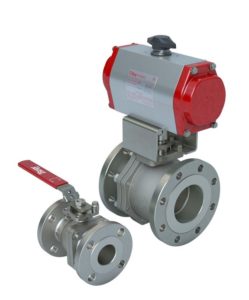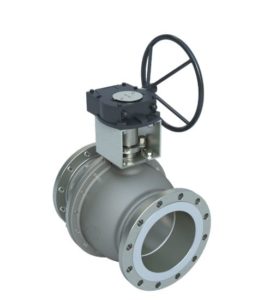Flanged Ball Valves
Flanged ball valves are flanged pipe fittings that contain one or more valves. They are used in process industries, power plants and other applications to control the flow of liquids and gases.
Flanged ball valves are available in a variety of materials and sizes, including steel and stainless steel. The flanges are attached to pipes using screw connections or welding. The valve components can be made from a variety of metals, including brass, stainless steel and forged carbon steel. Flanged ball valves are also available with different types of seats to accommodate specific chemical and environmental conditions.
Flange dimensions vary depending on the size and type of valve being specified for installation. The flange dimensions should always be provided by the manufacturer when requesting quotes or ordering replacement parts for your valve system!
1. Flanged ball valves are commonly used in both industrial and commercial applications.
2. They are often used to control the flow of fluids, gases, or slurries in pipelines.
3. Flanged ball valves can be operated manually or automatically and are available in
various sizes and materials to suit different applications.
Below are the recommended specifications
for the SlurryTuff™ Flanged Ball Valves
Series F15 / F30 Flanged Ball Valves
Body
> Body shall be offered in a two-piece, side entry assembly.
> Body shall be offered in cast material grades.
> 1/2″ – 4″ valve bodies shall be investment castings.
> Body casting shall be marked with a foundry heat code
for full traceability.
> Body shall be full port.
> Standard product shall be designed in accordance
with ASME B16.34 and pressure-temperature ratings
established by ASME B16.34.
> Body and end cap wall thickness shall meet or exceed
ASME B16.34 minimum wall thickness requirements.
> End flanges designed per international flange standard as
specified. ASME B16.5 | DIN EN 1092-1
> Valve face-to-face dimensions are in accordance with
ASME B16.10:
– Long Pattern: F15/F30, 1/2″ – 12″
– Short Pattern: F15, 1/2″ – 4″
– Short Pattern: F30, 1/2″ – 6″
> Materials are in accordance with NACE MR0175.
> Bolted body connection shall utilize a spiral wound,
316SS/graphite body joint gasket.
> For valve sizes 6″ through 12″, a ball support is utilized
to help maintain ball-to-seat contact and lower operating
torque.
> Carbon steel bodies and end caps are to be phosphate
coated for increased corrosion resistance.
> The body shall be designed for internal stem entry to
create a safe, blowout proof assembly
Stem
> The stem shall be a one-piece, blowout proof design.
> The stem shall have a double “D” design at the ball and
operator interface.
> The stem must contain (2) anti-static devices which
maintain constant contact with the body and ball to
eliminate risk of static discharge.
> As a standard, the stem for valve sizes 1/2″ to 2″ shall be
threaded for installation of the stem nut that is used to
compress the live-load, Belleville washers.
> As a standard, top portion of the stem for valves sizes
2-1/2″ to 12″ is non-threaded for utilization of an
independent packing gland.
> The standard stem material is ASTM A479 Type 316
stainless steel. Additional materials are available upon
request.
> For valve sizes 1/2″ to 2″, a lock washer is utilized to
prevent the stem nut from unthreading in high-cycle
automation applications due to vibration.
Ball
> Ball is to be precision machined and polished for a
smooth surface that will allow for bubble tight shut off
and low operating torque.
> The ball is provided with a pressure equalization hole
in the stem slot to equalize pressure between the body
cavity and the pipe when the valve is in the full open
position.
> The ball shall be offered in cast material grades. The
standard ball material is ASTM A351 Gr CF8M stainless
steel. Custom materials are available upon request.
> When metal seats are used, the ball shall receive
advanced coating or hard chrome plating. The ball is
to be 360° mate lapped with the seats after coating to
ensure proper sealing and low-torque.
Seat
> Seats are designed to ensure bidirectional, bubble tight
shut off with low operating torques.
> Resilient seats are designed with relief slots to allow body
cavity pressure relief past the upstream (high-pressure)
seat.
> Seats are positively preloaded to ensure low-pressure and
vacuum sealing ability.
> The standard resilient seat material is TFM 1600. Other
resilient seat materials available are: PTFE, RPTFE,
Tek-Fil™, UHMWPE, and PEEK.
> Metal seats are available and are ANSI/FCI 70-2 Class V
shut off rated.
> Metal seats are coated or hard faced for resistance to
wear, reduced torque, and extended seal surface life.
> Metal seats are 360° mate-lapped with the ball to ensure
proper sealing and low-torque.
> Wave springs are used with the metal seats to maintain
contact with the ball through thermal cycling.
> The standard metal seat base material is
ASTM A351 Gr. CF8M stainless steel.
> Utilizing metal seats allows for use of the valve in
temperatures up to 750°F.
> When metal seats are used, the valve becomes
unidirectional.
Packaging And Bearings
> Valve sizes 1/2″ – 2″ shall have a live-loaded, self-adjusting stem seal that utilizes Belleville
Washers.
The stem seal adjusts to compensate for changes in
temperature and normal wear.
> For valve sizes 1/2″ – 2″ where live-load stem sealing is
used, the stem nut is to be tightened until the Belleville
washers are flat and then the stem nut is to be backed off
½ turn and secured with the lock washer.
> Valves sizes 2-1/2″ – 12″ utilize an independent packing
gland that can be adjusted without removal of the
mounting hardware or operator. The packing gland
uniformly distributes load to the packing.
> The standard stem packing is composed of RPTFE
V-rings.
> The adjustable V-Ring stem seal design creates a seal
between the stem and body packing box. The stem
packing is composed of 3 or 4 seal rings (quantity
is dependent on size) to provide high-cycle life and
resistance to creep and cold flow.
> A thrust washer and thrust washer protector are required
to reduce torque and prevent galling.
> Graphite stem packing is available for fire safe
configurations in compliance with API 607. Graphite
packing is composed of a single ring.
> Combination packing (TFM / Graphite) stem packing is
available for valves with fugitive emissions requirements
to API 641 or ISO 15848-1.
Pressure Ratings
Bidirectional, Zero Leakage
> F15 – ASME Class 150 | PN 10 & 16
> F30 – ASME Class 300 | PN 25 & 40
Related Pages



